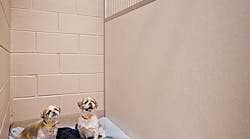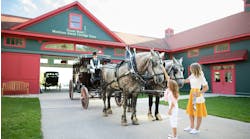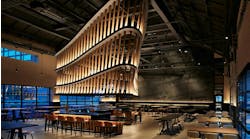Custom-made meals, personal massages, flat-screen TVs, luxury pools, and comfortable beds—these are just a few of the amenities that today’s top hotels offer. But did you know the same options are available for our pets?
Related: The Tile Council of North America Designs Custom Doghouses during Coverings 2018
A billion dollar industry that's only increasing.
Ashley Shoults, principal at Animal Arts in Boulder, Colo., said the pet boarding industry has grown significantly in recent years and will likely continue to do so. According to the American Pet Products Association (APPA) 2017-2018 National Pet Owners Survey, 68 percent of all U.S. households own pets. Last year, these pet owners spent $69.51 billion on their pets, a number that is estimated to increase to $72.13 billion this year with $6.16 billion being figured in for grooming and boarding.
The humanization of pets by millennials in particular has gone to the next level and continues to be a driving factor for the pet industry. From carefully curated subscription boxes (like BarkBox) to customizable swag that features photos of one’s pet, it’s easy to see that Gen Y pet owners are more likely to pay for any pet service including daycare, boarding, and at-home pet sitting.
“We send our kids to daycare while we’re at work, so why not send our dogs?” Shoults remarked. “Pet owners want more options for luxurious overnight accommodations for their animals so that they can take comfort in the knowledge that their pets are being well cared for with the comforts of home while they are away.”
Despite new apps like Rover that offer a range of pet care options, Shoults thinks people still feel better about boarding their pets in facilities designed exclusively for animals where they know their pets are being watched, cared for more frequently, and have more opportunities for play and social interaction.As an animal architectural firm, Animal Arts’ portfolio contains more than 800 animal care-related projects in over 40 states, Canada, and other international locations ranging in size from 600 square feet to 110,000 square feet. Two memorable projects the firm has worked on include two of the Olde Towne Pet Resort facilities as well as Tails of Terra Linda Pet Resort in San Rafael, Calif.
“Tails is a perfect example of a facility created by a veterinarian who wanted to add a complimentary luxury pet resort to their practice to provide full-service support to their clients and their community,” Shoults explained. Her favorite design aspect for this particular project is the rooftop play yard.
Other unique features Animal Arts’ clients have asked for include automatic dog waterers in suites, overhead garage doors in between play areas, bone- and guitar-shaped pools, individual webcams for owners to check on pets, and more.
Designing to be rough-housing ready.
Similar to building spaces for humans, many factors are taken into consideration when designing for animals. According to Shoults, some of the biggest aspects are durability of materials and finishes, cleanability, sound and odor control, and mitigating stress for the animals. For example, boarding layouts want to avoid having dogs facing each other across an aisle to limit barking and reactivity. Having a good flow of spaces in order to move pets through the facility in an efficient and effective way is also important.
Because animal housing areas need to be durable enough to stand up to the wear and tear of the animals themselves, as well as provide a lasting, cleanable surface, Animal Arts often utilizes masonry walls finished with a block filler and coated with a high-build epoxy paint. In high-traffic areas where users want a more high-end aesthetic look, Shoults said her team will often use porcelain tile on the floors and/or walls. Other considerations for materials and finishes can include a seamless epoxy floor system, moisture-resistant ceiling tiles, and ceiling tiles that have a high NRC (noise reduction coefficient).
Animal Arts’ expertise in animal architecture comes from its years of experience—the firm built its first veterinary hospital in 1985—and the team’s ability to constantly evolve and adapt as it continues to learn from both clients and projects. As traditional dog kennels continue to be replaced with premium pet resorts, animal architects like those at Animal Arts will likely remain in demand to keep humans happy and tails wagging.
Images courtesy of Olde Towne Pet Resort and Tails of Terra Linda.


